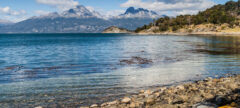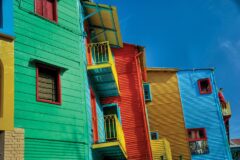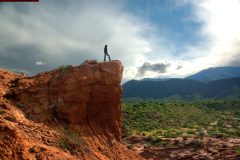Private Journeys
Active Argentina: Walking in Patagonia
15 days from £4,600pp
(based on two people sharing & excluding flights)
Essentials
-
Tour info
-
Country info
-
What's included
Tour info
Accommodation
This is a hotel-based holiday and there is no camping involved. We’ve picked simple yet cosy and comfortable lodgings as your base for exploring Patagonia where you can start your days with a filling breakfast and return to a hot shower. Your hotel in Bariloche is within easy reach of the city’s excellent restaurants. In El Chaltén you stay in an alpine-style lodge at the base of snow-capped mountains. And in Ushuaia there are views of the Beagle Channel from your hotel which is perched above the outskirts of town.
Climate
Winter in the Southern Hemisphere is between May and September. In Santiago and Buenos Aires, temperatures can be cool (5°C – to 15°C). While sunshine is possible, so is rain. Spring and autumn temperatures, October to November and March to April respectively, are between 15 and 25°C and there is a good deal of pleasant sunshine. January and February are hot, around 30°C.
In Los Glaciares and Tierra del Fuego National Parks the best months for hiking are March and April, when the autumn foliage is stunning. Many hikers also visit in summer – December to January – along with non-trekkers so it can be busy. Days are long and mild then but it can be windy, as in spring (September to October).
Clothing And Special Equipment
For towns and cities bring practical, comfortable clothing and a light-weight jumper. If you plan to eat in smart restaurants, although clothing is not formal (no need for jacket and tie), something quite smart would be appropriate.
Clothing for the Patagonia walking should cater for the fact that you may come across any kind of weather conditions from balmy sunshine and 25 degrees to blizzards and gale force winds. Items you can wear in layers are best. If you are familiar with walking poles, you’ll find them very useful in Patagonia. They both assist you on steep climbs and paths with loose stones, and help you keep your balance. Do bring a day pack (25-35 L) to carry your personal items, clothes and packed lunches. And of course it’s essential to have good, well-worn and waterproof walking boots with good grip and ankle support.
Currency
The unit of currency in Argentina is the Argentine peso. For the latest advice on how to carry you funds see our country FAQs section for Argentina.
Guides
We carefully select our local partners, some of whom we have worked with for over 35 years. Their English-speaking guides understand the expectations of our clients very well, and are consistently singled out for praise by the latter on their return.
Insurance
Travel insurance is not included and essential.
Trip Suitability
This is a busy holiday which should suit the actively-inclined weekend walker back home. Although we’ve thrown in a couple of long-distance trails, hiking is generally of low intensity and not technical. You should be agile and open to walking in all weathers but no special equipment or extra training are necessary. There are also a couple of scenic road journeys, and (Argentina being 11 times the size of Great Britain) four internal flights.
Over the 2-week holiday, 6 days are spent out and about with trails ranging from just a couple of hours to a full day (9-10 hours). More details are given in the day to day itinerary. Unlike in the Andes of Peru and Bolivia, you’re not walking at elevations associated with high altitude (the highest altitude reached is 1,700m on the optional Cerro Catedral trail). Should you have any questions, please get in touch.
Meals
Breakfast daily; lunch days 4, 8, 9, 10 and 12.
Summary Of Nights
15 days, 14 nights: Buenos Aires 2; Bariloche 2, El Calafate 2, El Chaltén 4, Ushuaia 3, Buenos Aires 1.
Tipping
Tips are expected and local guides often rely on their tip as a significant proportion of their income.
Most service industry workers will expect a tip of some kind and so it is useful to have spare change for hotel porters, taxi drivers and the like. It is common to leave 10 – 12% in restaurants.
Transport
Four flights (longest 3.5hrs); 2 road journeys (longest 3hrs).
Vaccinations
Preventative vaccinations are recommended against the following; typhoid; polio; tetanus; hepatitis A. For specific requirements you must consult your GP.
You can also find helpful information on the Masta Travel Health website.
Visas
Holders of a full British passport do not require a visa, although passports must be valid for at least 6 months after the trip begins. Anyone with a different nationality should enquire with us or check with the relevant consulate.
If flying to the US, or via the US you will need to fill in your online ESTA application.
Country info
When is the best time to visit Argentina?
Argentina is so large it’s always a good time to go somewhere. The southern hemisphere summer is the reverse of our own, with Dec-Feb being high summer in Patagonia. Spring (Oct-Nov) and Autumn (Mar-Apr) can still be very pleasant and are quieter. While summers in the lake district are reliably warm and sunny, the further south in Patagonia you go the more unpredictable the weather. In Winter (June-Sept) some hotels in Patagonia close, while others stay open for skiers. Buenos Aires, Mendoza and Córdoba enjoy a Mediterranean-type climate, with cool winters and very warm summers. North-west Argentina (Salta and Jujuy) enjoy sunshine and warm temperatures year-round but are influenced by altitude and the high Andes, with occasional cold snaps (June-Sept) and a rainy season (Jan-Feb). Iguazú Falls and Misiones has a subtropical climate, although it can be chilly July-Sept.
For more detailed information visit our When To Go section.
What is the official language of Argentina?
The official language of Argentina is Spanish.
What is Argentina's official currency?
The official currency of Argentina is the Argentine Peso.
Although cards have become more widely accepted, cash remains useful in Argentina so don’t rely solely on your cards. Taking funds in a mix of formats (a supply of US$ cash to convert into Pesos locally, along with your cards) is a sensible plan. In Buenos Aires and main tourist hubs you should have few problems paying by card but in more remote areas often only cash is accepted. You’ll also need cash for tips (eg if you pay for a restaurant meal with a card, tips are always left in cash). When changing money, denominations of US$50 and US$100 are usually preferred and you should make sure your notes are in perfect condition. Although ATMs are available, local ATM fees are high and the amount you can take out is lower than in the UK. We tend to avoid them.
We think it’s a good idea to keep an eye on Argentina’s exchange rates before you go. In addition to the official (BNA) rate of exchange for converting your US Dollars to Pesos, Argentina also uses a parallel exchange rate for foreign tourists (MEP). This is about 15% better than the official rate. Some casas de cambio will automatically apply the better tourist rate when changing your money. Others will only apply the official (BNA) rate. Rates used to process credit/debit card transactions can vary between card issuers, but you should find you get something between the official and tourist rates. Check your statement.
Try not to end up with a lot of leftover Pesos at the end of your time in Argentina, as it is difficult to change them to other currencies. You should be able to spend them at the Duty Free shop at Buenos Aires airport.
Please note that given the changeable situation with the Argentine economy, currency matters can change at short notice.
What's the time difference between Argentina and UK?
The time difference between Argentina and UK is GMT -3 hrs. Sometimes daylight saving is observed in the summer, from Sep/Oct to early Mar, but not every year.
Do I need a visa for Argentina?
Holders of a full British passport do not require a visa, although passports must be valid for at least 6 months after the trip begins. Anyone with a different nationality should enquire with us or check with the relevant consulate.
If flying to the US, or via the US you will need to fill in your online ESTA application.
What vaccinations do I need for Argentina?
Please check Travel Health Pro for information on health recommendations and vaccinations for the destinations you are visiting. Please note that many Latin American countries require proof of vaccination against Yellow Fever if you have recently travelled to another country where Yellow Fever is present.
Which other countries combine well with Argentina?
Chile, accessing the country by crossing the Andes over one of several scenic passes: from Salta in the northwest to the Atacama Desert, from Mendoza to Santiago, via the lakes crossing from Bariloche to Puerto Varas in the lake district and from El Calafate to Torres del Paine in Patagonia; Brazil, via the land crossing at Iguazú.
What are the festivals and other cultural or sporting events in Argentina?
• Tango Festival: Buenos Aires, August.
• Polo Open: Buenos Aires province, weekends in November.
• Gaucho Festivals: The pampas, early November.
How do I adapt to the altitude in Argentina?
Whilst a typical holiday in Patagonia presents no challenges with altitude, Argentina’s north-western provinces offer a taste of the high Andes with some spectacular road trips on offer. Travel to high altitude can cause mountain sickness and even if you feel fighting fit it’s important to take things easy and stay hydrated (drink plenty of water, avoiding alcohol and caffeine) as you get used to the thin, dry air. You may initially notice a headache, dizziness or breathlessness and this usually improves with acclimatisation. If you are pregnant or taking the contraceptive pill, have a medical condition such as heart or lung condition, anaemia, asthma, high blood pressure you should seek the advice of your GP before booking. We also recommend you check your travel insurance covers travel to high altitude. If you’re taking the family, remember small children may be less capable of communicating altitude-related symptoms effectively: keep an eye on them too. Rest assured we will plan your itinerary carefully, taking into account any time spent at altitude. If you have any questions or concerns about altitude please speak to your travel expert.
Further advice on travel to altitude is available on www.travelhealthpro.org.uk
Inspired by this trip
Our exciting range of articles on Latin America explore everything from iconic destinations and lesser-known cultural gems to delicious traditional recipes. You’ll also find exclusive travel tips, first-hand client reviews and the chance to get your personal questions answered by our travel experts.
Papagaio
Your edit for Latin American inspiration
Our exciting range of articles on Latin America explore everything from iconic destinations and lesser-known cultural gems to delicious traditional recipes. You’ll also find exclusive travel tips, first-hand client reviews and the chance to get your personal questions answered by our travel experts.
View Extraordinary Inspiration







































